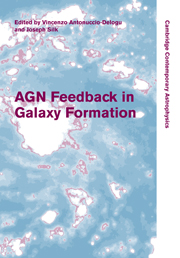Book contents
- Frontmatter
- Contents
- List of contributors
- Preface
- The organising committees
- Part I AGNs, starbursts and galaxy evolution
- Part II Co-evolution of black holes and galaxies
- Part III Outflows and radio galaxies
- Part IV Models and numerical simulations: methods and results
- 12 Physical models of AGN feedback
- 13 Large-scale expansion of AGN outflows in a cosmological volume
- 14 Relativistic jets and the inhomogeneous interstellar medium
- 15 AGN feedback effect on intracluster medium properties from galaxy cluster hydrodynamical simulations
- 16 Physics and fate of jet-related emission line regions
- 17 Cusp–core dichotomy of elliptical galaxies: the role of thermal evaporation
- Index
13 - Large-scale expansion of AGN outflows in a cosmological volume
from Part IV - Models and numerical simulations: methods and results
Published online by Cambridge University Press: 10 November 2010
- Frontmatter
- Contents
- List of contributors
- Preface
- The organising committees
- Part I AGNs, starbursts and galaxy evolution
- Part II Co-evolution of black holes and galaxies
- Part III Outflows and radio galaxies
- Part IV Models and numerical simulations: methods and results
- 12 Physical models of AGN feedback
- 13 Large-scale expansion of AGN outflows in a cosmological volume
- 14 Relativistic jets and the inhomogeneous interstellar medium
- 15 AGN feedback effect on intracluster medium properties from galaxy cluster hydrodynamical simulations
- 16 Physics and fate of jet-related emission line regions
- 17 Cusp–core dichotomy of elliptical galaxies: the role of thermal evaporation
- Index
Summary
Introduction
Outflows from AGN are observed in a wide variety of forms: radio galaxies, broad absorption line quasars, Seyfert galaxies exhibiting intrinsic absorption in the UV, broad emission lines, warm absorbers and absorption lines in X-rays (e.g. Creenshaw et al. 2003; Everett 2007). There have been studies on the cosmological impact of quasar outflows on large scales (Furlanetto & Loeb 2001, here after FL01; Scannapieco and Oh 2004, hereafter SO04; Levine & Gnedin 2005, hereafter LG05). Barai (2008) investigated the cosmological influence of radio galaxies over the Hubble time. All these studies considered spherically expanding outflows.
On cosmological scales an outflow is expected to move away from the highdensity regions of large-scale structures, with the outflowing matter getting channelled into low-density regions of the universe (Martel and Shapiro 2001). We implement such anisotropic AGN outflows within a cosmological volume. The simulation methodology is given in Section 13.2, and the results are discussed in Section 13.3.
The numerical setup
N-body simulation and distribution
We simulate the growth of large-scale structures in a cubic cosmological volume of comoving size Lbox = 128h−1 Mpc. We use the particle-mesh (PM) algorithm, with 2563 equal-mass particles, on a 5123 grid. A particle has a mass of 1.32 × 1010M⊙, and the grid spacing is Δ = 0.25h−1 Mpc. We consider a concordance ∧CDM model with the cosmological parameters:ΩM = 0.268, Ω∧ = 0.732, H0 = 70.4 km s−1 Mpc−1, Ωb = 0.0441, ns = 0.947, and TCMB = 2.725.
- Type
- Chapter
- Information
- AGN Feedback in Galaxy Formation , pp. 157 - 164Publisher: Cambridge University PressPrint publication year: 2010

